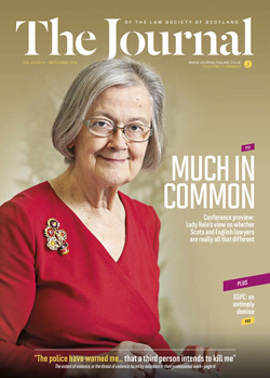Court reforms: still an unknown quantity
Last month saw the publication of the Civil Justice Statistics in Scotland for the year 2016-17. These latest statistics suggest that a total of 73,640 cases were initiated in the Scottish civil courts during that period. This represents a drop of 5% from the previous year, and an overall decrease of 44% since 2008-09. Prior to 2008-09 there are no available reliable statistics, due to inconsistencies in the way courts previously captured and recorded civil data. Indeed publication of the statistics was suspended in 2002.
The period of recording since 2008-09 has coincided with what has been described as arguably the greatest period of reform of civil litigation procedure in Scotland in over a century. So do the latest statistics reflect the impact of these ongoing reforms? It is perhaps still too early to measure the effect of many of the reforms, a number of which are yet to be brought into practice. Implementation of justice reform is, for the most part, not a speedy process.
It's the economy
Perhaps one explanation can be found by a closer examination of the types of cases being brought before the civil courts. In 2008-09, a total of 131,639 cases were initiated in the Scottish civil courts. Of that figure, a total of 95,883 cases related to debt, repossession or eviction proceedings. The latest figures show that by 2016-17, that figure had dropped by more than 50%, to 46,624.
2007-08 saw a global economic crisis. It is an expected consequence of an economic crisis that the number of court actions brought before the civil courts will increase, particularly in respect of debt, repossession and eviction actions. Since 2008-09, there has been, in the main, a steady decline in the number of these types of actions being brought before the Scottish courts, which is consistent with the economic recovery since that time. One exception is in respect of the number of eviction proceedings being raised which, whilst still significantly lower than in 2008-09, has witnessed an increase in cases being brought since 2012-13, when there was a substantial drop following the measures to strengthen the protection for social sector tenants against eviction introduced by the Housing (Scotland) Act 2010, which came into effect in August 2012.
Personal injury: bucking the trend?
Another category of case which has witnessed an increase is personal injury actions. The figures for 2016-17 show a 20% increase in personal injury cases since 2008-09, which contrasts with the overall trend. However, the number of personal injury cases being brought has fluctuated on an annual basis, making identification of any particular trend difficult, albeit the 2016-17 statistics show a decline for the second consecutive year for the first time since publication of the figures recommenced. This may, in part, result from the introduction of a compulsory protocol for personal injury claims up to a value of £25,000. The anecdotal evidence suggests that fewer lower-value claims are being litigated, which is consistent with the statistics. Insurers have also welcomed the new compulsory protocol, which has resulted in many more claims resolving without the need for litigation.
With the imminent introduction of qualified one-way costs shifting, which has the practical effect of removing the risk of the individual bringing the claim being held responsible for the other party’s costs, even if the claim is unsuccessful, there is potential for this trend to be reversed and for there to be a significant increase in the number of claims being litigated.
It is evident that despite the drop in the number of personal injury claims being litigated, the number of claims actually being made continues to rise. Statistics recovered from the Department of Work & Pensions suggest an increase in the number of personal injury claims registered for the year 2015-16 (the most recent available statistics), which may suggest that the introduction of the compulsory protocol is having an even greater impact on the number of cases being litigated than even that disclosed by the latest statistics.
It may well be that the published statistics cover too short a time period to enable the impact of any changes in legislation and court reform to be meaningfully assessed. Time will tell.
In this issue
- Confidence restored: internal investigations and legal privilege
- Court reforms: still an unknown quantity
- Ruled out of court?
- Uncovering the environment (1)
- Medical death: a case to answer
- Reading for pleasure
- Opinion: Kerry Trewern and Rhona McNair
- Book reviews
- Profile: Ryan McCuaig
- President's column
- Developing digital services
- People on the move
- Leading judgment
- Health check
- Open to attack
- Claims: beating the trigger
- Storage: time for digital
- GSPC: eulogy for a friend
- Relevant persons: a challenge
- New specialist land registration practice launches
- Good enough reason?
- Copyright: underpinning control
- Writing means writing
- Rent moves: two crucial hoops
- Debtor wins in policy decision
- Scottish Solicitors' Discipline Tribunal
- KIR: the time bomb explodes
- The guideline goal
- GC NextGen: a network for you?
- Your Law Society of Scotland Council members
- Public policy highlights
- Double boost for Society's AML team
- Ask Ash
- Practice rights and the impact of Brexit: working in the EU
- Acting as notary: what do I need to know?
- Engagement letters: a practical approach
- Uncovering the environment
- Paralegal pointers






